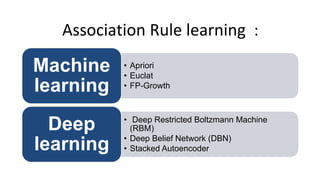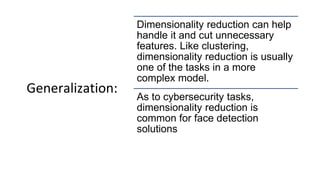Machine learning in computer security
- 1. Machine Learning in Computer Security Presented by : Kishor Datta Gupta
- 2. Computer security Task of cyber security Prediction Prevention Detection Response Monitoring Places to do the task Network (network traffic analysis and intrusion detection) Endpoint (anti-malware) Application (WAF or database firewalls) User (UBA) Process (anti-fraud) Time to do the tasks In transit in real time At rest Historically
- 3. What Machine Learning Can Do? • A task of predicting the next value based on the previous values. Regression (or prediction) • A task of separating things into different categories. Classification • Similar to classification but the classes are unknown, grouping things by their similarity. Clustering • A task of recommending something based on the previous experience. Association rule learning (or recommendation) • A task of searching common and most important features in multiple examples. Dimensionality reduction or generalization • A task of creating something based on the previous knowledge of the distribution. Generative models
- 4. Regression: The knowledge about the existing data is utilized to have an idea of the new data. Example : house prices prediction. Example in Cyber security: it can be applied to fraud detection. The features (e.g., the total amount of suspicious transaction, location, etc.) determine a probability of fraudulent actions.
- 5. Regression • Linear regression • Polynomial regression • Ridge regression • Decision trees • SVR (Support Vector Regression) • Random forest Machine learning • Artificial Neural Network (ANN) • Recurrent Neural Network (RNN) • Neural Turing Machines (NTM) • Differentiable Neural Computer (DNC) Deep learning
- 6. Linear Regression: • Linear regression performs the task to predict a dependent variable value (y) based on a given independent variable (x) • . So, this regression technique finds out a linear relationship between x (input) and y(output). Hence, the name is Linear Regression. • Y=MX+C
- 7. Polynomial Regression: 2 Degree polynomial y = θo + θ₁x₁ + θ₂ x₁² General equation of a polynomial regression is: Y=θo + θ₁X + θ₂X² + … + θₘXᵐ
- 8. Decision Tree • The goal of using a Decision Tree is to create a training model that can use to predict the class or value of the target variable by learning simple decision rules inferred from prior data(training data). • In Decision Trees, for predicting a class label for a record we start from the root of the tree. We compare the values of the root attribute with the record’s attribute. • On the basis of comparison, we follow the branch corresponding to that value and jump to the next node.
- 9. Regression Evaluations MAE (Mean absolute error) represents the difference between the original and predicted values extracted by averaged the absolute difference over the data set. •MSE (Mean Squared Error) represents the difference between the original and predicted values extracted by squared the average difference over the data set. •RMSE (Root Mean Squared Error) is the error rate by the square root of MSE. •R-squared (Coefficient of determination) represents the coefficient of how well the values fit compared to the original values. The value from 0 to 1 interpreted as percentages. The higher the value is, the better the model is.
- 10. Classification: Classification refers to a predictive modeling problem where a class label is predicted for a given example of input data. In terms of cybersecurity, a spam filter separating spams from other messages can serve as an example.
- 11. Classification: • LogisticRegression (LR) • K-Nearest Neighbors (K-NN) • Support Vector Machine (SVM) • KernelSVM • NaiveBayes • DecisionTreeClassification • Random Forest Classification Machine learning • Artificial Neural Network • Convolutional Neural Networks Deep learning
- 12. Support Vector Machine (SVM): The objective of the SVM is to find a hyperplane in an N- dimensional space(N — the number of features) that distinctly classifies the data points.
- 13. Naïve Bayes: It is a probabilistic classifier that makes classifications using the Maximum A Posteriori decision rule in a Bayesian setting. Naive Bayes classifiers have been especially popular for text classification, and are a traditional solution for problems such as spam detection.
- 14. Artificial Neural Network: The core component of ANNs is artificial neurons. Each neuron receives inputs from several other neurons, multiplies them by assigned weights, adds them and passes the sum to one or more neurons. Some artificial neurons might apply an activation function to the output before passing it to the next variable. Artificial neural networks are composed of an input layer, which receives data from outside sources (data files, images, hardware sensors, microphone…), one or more hidden layers that process the data, and an output layer that provides one or more data points based on the function of the network.
- 15. Classification Evaluations Accuracy Accuracy = (TP+TN)/(TP+FP+FN+TN) Accuracy is the proportion of true results among the total number of cases examined. Precision •. what proportion of predicted Positives is truly Positive? •Precision = (TP)/(TP+FP) Recall • what proportion of actual Positives is correctly classified? •Recall = (TP)/(TP+FN) F1 Score • Harmonic Mean of precision and recall.
- 16. Clustering: The information about the classes of the data is unknown. There is no idea whether this data can be classified. This is unsupervised learning. Supposedly, the best task for clustering is forensic analysis. The reasons, course, and consequences of an incident are obscure. It’s required to classify all activities to find anomalies. Solutions to malware analysis (i.e., malware protection or secure email gateways) may implement it to separate legal files from outliers. Another interesting area where clustering can be applied is user behavior analytics. In this instance, application users cluster together so that it is possible to see if they should belong to a particular group. Usually clustering is not applied to solving a particular task in cybersecurity as it is more like one of the subtasks in a pipeline (e.g., grouping users into separate groups to adjust risk values).
- 17. Clustering : • K-means • Mixturemodel(LDA) • DBSCn • Bayesian • GaussianMixtureModel • Agglomerative • Mean-shift Machine learning • Self-organized Maps (SOM) • Kohonen Networks Deep learning
- 18. K-Means Clustering K-Means finds the best centroids by alternating between (1) assigning data points to clusters based on the current centroids (2) choosing centroids (points which are the center of a cluster) based on the current assignment of data points to clusters.
- 19. Association Rule learning Netflix and SoundCloud recommend films or songs according to your movies or music preferences. In cybersecurity, this principle can be used primarily for incident response. If a company faces a wave of incidents and offers various types of responses, a system learns a type of response for a particular incident (e.g., mark it as a false positive, change a risk value, run the investigation). Risk management solutions can also have a benefit if they automatically assign risk values for new vulnerabilities or misconfigurations built on their description.
- 20. Association Rule learning : • Apriori • Euclat • FP-Growth Machine learning • Deep Restricted Boltzmann Machine (RBM) • Deep Belief Network (DBN) • Stacked Autoencoder Deep learning
- 21. Generalization: Dimensionality reduction can help handle it and cut unnecessary features. Like clustering, dimensionality reduction is usually one of the tasks in a more complex model. As to cybersecurity tasks, dimensionality reduction is common for face detection solutions
- 22. Generalization : • Principal Component Analysis (PCA) • Singular-value decomposition (SVD) • T-distributed Stochastic Neighbor Embedding (T-SNE) • Linear Discriminant Analysis (LDA) • Latent Semantic Analysis (LSA) • Factor Analysis (FA) • Independent Component Analysis (ICA) • Non-negative Matrix Factorization (NMF) Machine learning • Auto encoder Deep learning
- 23. Generative models: Generative models are designed to simulate the actual data (not decisions) based on the previous decisions. The simple task of offensive cybersecurity is to generate a list of input parameters to test a particular application for Injection vulnerabilities. Alternatively, we can have a vulnerability scanning tool for web applications. One of its modules is testing files for unauthorized access. These tests are able to mutate existing filenames to identify the new ones. For example, if a crawler detected a file called login.php, it’s better to check the existence of any backup or test its copies by trying names like login_1.php, login_backup.php, login.php.2017. Generative models are good at this.
- 24. Generative models : • Markov Chains • Genetic Algorithm Machine learning • Variational Autoencoders • Generative adversarial networks (GANs) • Boltzmann Machines Deep learning
- 25. Machine learning for Network Protection ML in network security implies new solutions aimed at in-depth analysis of all the traffic at each layer and detect attacks and anomalies. How can ML help here? • Regression to predict the network packet parameters and compare them with the normal ones; • Classification to identify different classes of network attacks such as scanning and spoofing; • Clustering for forensic analysis.
- 26. Machine learning for Endpoint Protection The new generation of anti-viruses is Endpoint Detection and Response. It’s better to learn features in executable files or in the process behavior. Data may differ depending on the type of endpoint (e.g., workstation, server, container, cloud instance, mobile, PLC, IoT device) but the tasks are common How can ML help here? • Regression to predict the next system call for executable process and compare it with real ones; • Classification to divide programs into such categories as malware, spyware and ransomware; • Clustering for malware protection on secure email gateways (e.g., to separate legal file attachments from outliers).
- 27. Machine learning for Application Security Application security can differ. There are web applications, databases, ERP systems, SaaS applications, micro services, etc. How can ML help here? • Regression to detect anomalies in HTTP requests (for example, XXE and SSRF attacks and auth bypass); • Classification to detect known types of attacks like injections (SQLi, XSS, RCE, etc.); • Clustering user activity to detect DDOS attacks and mass exploitation.
- 28. Machine learning for User Behavior There are domain users, application users, SaaS users, social networks, messengers, and other accounts that should be monitored. User behavior is one of the complex layers and unsupervised learning problem. As a rule, there is no labelled dataset as well as any idea of what to look for. How can ML help here? • Regression to detect anomalies in User actions (e.g., login in unusual time); • Classification to group different users for peer-group analysis; • Clustering to separate groups of users and detect outliers
- 29. Machine learning for Process Behavior it’s necessary to know a business process in order to find something anomalous. Business processes can differ significantly. You can look for fraud in banking and retail system, or a plant floor in manufacturing. How can ML help here? • Regression to predict the next user action and detect outliers such as credit card fraud; • Classification to detect known types of fraud; • Clustering to compare business processes and detect outliers.
- 30. References • https://towardsdatascience.com/machine-learning-for-cybersecurity-101-7822b802790b • AI for Cybersecurity by Cylance(2017)- Short but good introduction to basics of ML for Cybersecurity. Good practical examples. • Machine Learning and Security by O’reilly ( January 2018 ) — Best book so far about this topic but very few examples of Deep Learning and mostly a general Machine Learning • Machine Learning For Penetration Testers, by Packt ( July 2018 )- Less fundamental than previous one, but have more Deep Learning approaches






























